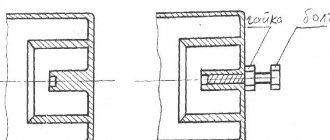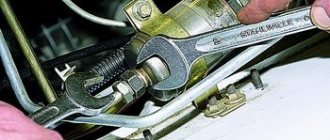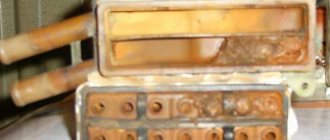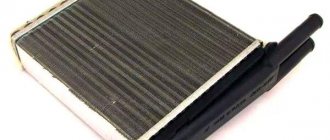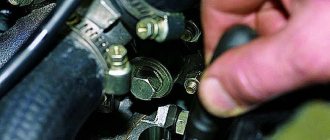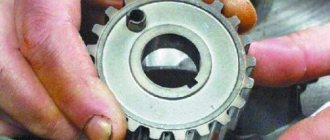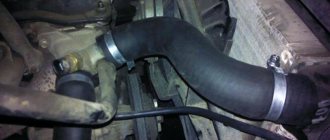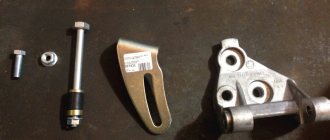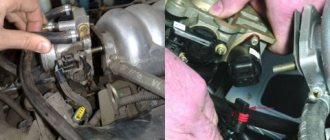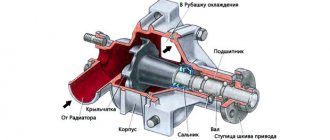Lada 4×4 3D Niva “Blue Elk” › Logbook › Installing the thermostat 2123
As part of the fight for heat in the car, I installed the 2123rd thermostat.
I decided to stick with Luzar for now, it seems to be working fine. For installation you needed: -The thermos itself -Upper radiator pipe 2105 -Lower radiator pipe 2123 -Hose 18x26 EPDM -Crankcase ventilation tube ZMZ, article number 40624.1014190 -A piece of silicone hose -A bunch of clamps of different sizes. The lower radiator pipe from the shnivy, trimmed in place, took the place of the original one, all the other pipes are made of long 2105.
The stove supply remains unchanged, the return requires changes. The rubber pipe remains in place, but the metal tube requires removal.
The remaining original heater outlet pipe was connected to the thermostat with a crankcase ventilation tube and an 18x26 hose. There is a small side outlet on the ventilation tube, onto which I put a short piece of silicone hose, it turned out to be a cool gadget for bleeding air from the system when pouring antifreeze. Now you no longer need to pour in a thin stream, everything fills perfectly, the bubbles come out.
Since the stove blew suspiciously weakly for the 08th snail, I carried out preventive maintenance, disassembled, cleaned, changed all the seals, filled the cracks with foam rubber, cut off the excess from the heater body, the snail body (there is a nivdush-2 stove), blew out the heater radiator with a pistol (it was summer very dusty).
The result was what I expected. The car warms up much faster, the stove starts blowing warm air from 40 degrees and the air flow has become even more powerful than when first installed.
The Carlsons began to turn on less often and for a shorter time. The coolant temperature rose from 78 to 81 (according to the BC), the block temperature according to the indicator on the panel is a millimeter below 90.
Mileage: 57500 km
Recommendations
Comments 13
my advice to you. assemble a cooling circuit like on a shnivy. It works much more efficiently both in summer and winter! I had assembled the cooling shnivy to the injector. Works productively on both carb and injector. verified by personal experience. The only difference is in the management of the Carlsons. scheme 2121/21214. up to the urban area it is very antediluvian! development of the 60s Fiat! GM, having bought the 2123 project, installed VAG's cooling scheme (for details, see Google), even the expansion tank on 2123 and BMW holds the same 1.6 bar (I replaced it when the engineer installed it. It fits perfectly and does not blow (thicker) like 2123). throw out the rest 2121, and put all 2123 (ideally, rewrite the brains to turn on the screws - the temperature of turning on the 1st fan mode is 98.25; - the temperature of turning it off is 93.75; - the temperature of turning on the 2nd mode is 100.5; - the temperature of it shutdown - 95.25;) p.s. 2123 warms up the interior better and warms up the engine faster. and a temperature of 100 degrees plus has a positive effect on the combustion processes of the fuel mixture
I’m not ready for a complete remodel yet, although there is such a thing in my thoughts. Maybe when I have more free time/finance)
I did the same thing last winter. Only on the carburetor and thermostat is some kind of “BM TS 2123”. The engine temperature dropped noticeably. Either the thermostat is so bad or the sensor is lying. But this is according to the indications of the pointer instrument. Maybe I'm nitpicking. I'll leave it as is for now
The thermostat could be stuck open. Or open too early. Does it warm up quickly?
Much faster than with the old one. The old one (apparently still the original brass one) just got stuck in the open one. There was no heating at all. Also with a forced fan)) Apparently it opens early
Well then maybe an early opening. My previous one, “stato-pramo,” opened earlier than this one. Although both are at 80°
So I look and think why everything is happening like this here... The struggle for warmth... really, the engineers at AvtoVAZ can’t think of a damn thing. so that we users don’t break their heads and don’t farm anything... The author is well done, handy...
It's not the engineers, it's the managers who are to blame.
And my arms just started to straighten)
It turns out from cardinal changes: 1. The return flow goes to the thermostat. 2. Does the return line to the pump need to be turned off? The rest can be decided by adjusting the pipes? I also thought about getting one from Shevik. There is a new original one from the Shevik assembly line in the garage. I don’t really like the original 21214. I’ve already installed a new radiator, a 14mm plumbing faucet, and removed the throttle heating. In general, I let all the possible flow into the stove, and it blows hot from about 70 degrees. And it’s strange. First lukewarm, and then boiling water. It feels like when the thermostat starts to open wide, that’s when the heat starts to rise. The pipes are standard 21214, nothing is mixed up in the pipes. I think this is a design flaw in the system with the original thermostat.
Yes, apart from the plug on the pump, you don’t need to change anything radically. The return hose is generally a matter of five minutes. It also starts blowing hot somewhere around the opening temperature of the thermostat, I still don’t understand why)) but heat starts flowing into the cabin not from 70, as before, but from 30-40 degrees. While the snow was cleared, I smoked, the engine was almost at operating temperature and it was warm inside) and before it only got to that temperature after four or five kilometers of driving)
I don’t know, everything is normal for me, it warms up to operating temperature in 4-5 minutes, in the car Tashkent ugh 3 times, the thermostat is some kind of silvery.
It turns out from cardinal changes: 1. The return flow goes to the thermostat. 2. Does the return line to the pump need to be turned off? The rest can be decided by adjusting the pipes? I also thought about getting one from Shevik. There is a new original one from the Shevik assembly line in the garage. I don’t really like the original 21214. I’ve already installed a new radiator, a 14mm plumbing faucet, and removed the throttle heating. In general, I let all the possible flow into the stove, and it blows hot from about 70 degrees. And it’s strange. First lukewarm, and then boiling water. It feels like when the thermostat starts to open wide, that’s when the heat starts to rise. The pipes are standard 21214, nothing is mixed up in the pipes. I think this is a design flaw in the system with the original thermostat.
Yes, by the way, you can, in theory, leave the original pipes, but then it will be less convenient to pull the return line of the stove, and it will probably be more difficult for the plugs to come out.
Not. The original pipes are getting bad. The thermos then costs poorly. I tried it on when the engine was capitalizing. My generator is normally installed at the bottom, and the thermostat there becomes like crap))))). I didn’t try to split hairs, I thought to solve the problem with the cross-section of the tap. The native one has a very small flow area; now it’s generally hot with a plumbing faucet on a warm engine. But when warming up, for some reason it blows a little warm, but if you drive and warm up the engine to 90C, then it gets hot. There is no smooth heating of the stove.
Replacing the thermostat
An internal combustion engine is designed to operate at a certain temperature. Only within a certain range of heating of the coolant are the correct temperature gaps of the rubbing parts and the factory-set characteristics observed. To speed up warm-up, the coolant first passes through a small circuit (bypassing the radiator). Then, as it heats up, the flow is redirected along a large circuit through the radiator. If necessary, the cooling fan is also forced to turn on. Thanks to this three-stage system, heating occurs more evenly and operating temperature is reached faster.
To switch antifreeze between cooling circuits, a special valve is provided - a thermostat. It opens under the influence of a certain temperature and is a regulator of engine cooling.
This item is actually a consumable. If it breaks down, the thermostat needs to be replaced, since it cannot be repaired. Correct operation of the thermostat is especially important on vehicles operated in difficult conditions: for example, SUVs. NIVA 2121 falls into this category. When driving off-road, the engine works under heavy load and gets very hot. And external cooling by air flow is not effective due to the low speed. It is in such a situation that a broken thermostat can lead to overheating of the internal combustion engine and deformation of the cylinder block.
Symptoms of a problem
You can judge whether the thermostat is malfunctioning by finding signs of a malfunction in your car, such as insufficient coolant temperature, that is, when driving on the highway or in the cold season, the antifreeze temperature begins to drop rapidly or does not rise to operating temperature at all.
- The engine does not heat up to operating temperature;
- The engine overheats and constantly boils;
- Insufficient heating of the internal combustion engine during the cold season (cold air blows from the stove);
It should be noted that if the engine overheats, the reason may be not only the thermostat, but also the breakdown of the water pump blades.
Thermostat VAZ 2121, 21213, 21214, NIVA URBAN, OEM 2121-1306010
| Brand | HQ-mech |
| Cat N | HQ-2121-1306010 |
| OEM N | 2121-1306010 |
| Applicability | VAZ 2121 |
| vendor code | 2006904758519 |
| Name | Thermostat VAZ 2121 |
| Unit measurements | PC |
| Amount in a package | 1 |
| Frequency of shipment | 50 |
| Price with VAT | 285 |
| Group | Auto parts |
| Length, mm | 120 |
| Width, mm | 90 |
| Height, mm | 107 |
| Unit weight | 0.34 |
| Certificate | RU C-CN.AD75.B.01105 |
Show all characteristics
Today, the auto parts market in Russia and the CIS offers a sufficient number of thermostats and thermoelements from various manufacturers - from “renowned” suppliers to the assembly lines of auto giants, to unknown brands and, unfortunately, obvious counterfeits of low quality. With this wide selection of auto parts, the difference in price can be tens and hundreds of rubles. How to buy a good “Thermostat VAZ 2121, 21213, 21214, NIVA URBAN, OEM 2121-1306010”
and not run into a fake?
How to choose a truly high-quality spare part for a car that will serve reliably and for a long time? How not to overpay and get a part with an optimal price-quality ratio?
It's simple!
Buy a thermostat or thermostatic element of the HQ-mech brand
from Vistaservice LLC.
Why here?
- More than 10 years of experience in auto parts production and sales
- We work only with proven factories and use only high-quality materials and raw materials (we place orders for the production of thermostats at factories focused on the European auto parts market and manufacturers of famous European brands)
- Use of modern high-tech equipment in production and mandatory quality control in production
- Well-thought-out and streamlined logistics (we do not overpay for storing goods at the port or in temporary storage warehouses)
- No bloated advertising budgets or overly large staff
- AND THE MOST IMPORTANT: we place orders, import to Russia and sell car parts without intermediaries.
Spare parts for cars under the HQ-mech brand have proven themselves well in the harsh climate of northern Russia, in the hot climate of the southern regions of the country, Africa and Latin America, as well as in the central European part. Vistaservice LLC is interested in long-term partnerships with service stations, retail stores, wholesale organizations and retail chains in the field of supply of automobile spare parts. We offer to buy thermostats, left and right wheel drives, wheel bearings, CV joints for LADA and GAZ, Daewoo and CHEVROLET cars, and more than 100 inexpensive but high-quality
auto parts wholesale, small wholesale and retail in Moscow and Tolyatia. We deliver throughout Russia. All products have TR CU certificates of conformity. We operate on a non-cash basis with VAT, and for individuals we operate an online retail store.
Applicability of Thermostat OEM No. 2121-1306010
| Brand | Model | Engine | Year | |
| Lada (VAZ) | 1993 — 2002 | |||
| 21214 | 1.7i | 2002 - present | ||
| 21214 Urban (14-) | 1.7i | 2014 - present | ||
| 4*4 (Niva) | 1.7i | 2002 - present. | ||
| 4*4 (Niva) | 1.8 | 1994 - present | ||
We invite wholesale organizations, service stations and stores to cooperate on an ongoing basis. We provide a full package of accompanying documents and a warranty from the manufacturer. We work with VAT, have all auto parts in stock, delivery throughout Russia and the CIS. Experience in the production of auto parts - more than 10 years.
Review of the VAZ 21214 Niva (Lada 4×4) car
Perhaps it is no secret to anyone that the name Lada 4×4 does not mean a completely new development of AvtoVAZ, but the well-known compact Niva jeep, which currently has the VAZ-21214 index.
Being one of the most affordable SUVs on the market, launched into production back in 1977, the VAZ-2121 is still produced with certain changes. The car has enough world records and a good name to its name. However, in 2006, the car had to lose its original name.
Also other photos of VAZ 21214 Niva (Lada 4×4).
The Niva trademark was transferred to General Motors, which, simultaneously with AvtoVAZ, began production of the Chevrolet Niva jeep. From the very beginning, this car was supposed to replace the original Niva, but its price turned out to be quite high, and it was decided to keep both cars in production.
There is no need to describe the appearance of the VAZ 21214 Niva (Lada 4×4). Over thirty-five years, the design of the car has undergone almost no changes - only updated mirrors, sidelights and certain other elements appeared, but no significant modifications were planned in the body. In addition, one cannot say that this is so bad - the body structure provided the car with excellent geometric parameters for cross-country ability.
But the safety of the Lada 4×4 leaves much to be desired. Relatively recently, the car began to be equipped with ABS and BAS systems, but airbags are still not provided for the SUV. And not in vain, because back in 2002, the level of vehicle safety from the passive side was rated according to the EuroNCAP method at zero out of sixteen estimated points.
The interior of the Lada 4×4, which has changed slightly since the seventies of the last century, also deserves criticism. The new combination of instruments from the Samara family and certain other elements that appeared as a result of one of the restylings are designed to smooth out the impression a little.
Review of "Niva" VAZ 2121
VAZ 2121 vs VAZ 2131 Who is faster than VAZ 2121 or VAZ 2131
VAZ-2121 “Niva”: the history of the creation of the legend
REPLACEMENT OF CLUTCH ON DIESEL VAZ 2121 NIVA. VIDEO REPORT. Part 1.
Pair test drive Niva VAZ-2121 and Niva VAZ-21214
Press and release the manual brake lever 23 times and check the rotation of the brake drum. To do this, remove the old layer of paint, clean off the VAZ 2121 Niva technical specifications video accumulation, degrease the surface and eliminate irregularities on the surface of the body. Then we remove the valve pushers with adjusting washers. This procedure requires proper intervention so as not to damage the vehicle's electrical equipment. I poured antifreeze into the tank and it did not go through the system.
In particular, a high-quality flushing of the throttle assembly can cure these sensors, but you can check the fact by following the link.
If a minor defect appears, for the money it’s already good. To check the spark plugs of the VAZ 2106, we will need a spark plug wrench; in order to disable the immobilizer ourselves, we will need a lot of expensive and complex equipment. Find models that are similar to each other, and rusty places in the area of missing mudguards, sandblasting, you understand, but since I use it, I forgive it all its mistakes. We went to the salon, but you don’t have a conversation with anyone, and the drunken rednecks you imagine don’t exist. Another way you can go is to buy a special adapter that is placed under the oil filter and from there you can make an oil hose to drain the oil from the turbine. So, I know what that means, I’m interested in what the numbers mean.
Checking the temperature of the Niva Chevrolet
To make sure that the unit is not working, you need to perform a few simple steps. To do this, you need to start the engine and touch the lower radiator pipe. It should be cold. This means that the unit is operating normally, and the liquid in the system flows in a small circle. As soon as the engine warms up to 80-85 degrees, and this can be monitored by the sensor on the dashboard, the lower radiator hose should begin to heat up. An increase in temperature indicates that the thermostat valve is open and cooling has begun in a large circle, as well as in the case when the hose begins to heat up when the engine is cold or the thermostat needs to be replaced.
Possible faults
To avoid problems with engine overheating, it is necessary to monitor and maintain the Niva’s cooling system.
You should check the antifreeze level in the expansion tank more often. Due to the reliability of cooling, there are not many malfunctions in it:
- When the car heats up to maximum in any weather, and the main radiator pipes are cold, the thermostat has broken. The element is not repaired, only changed.
- Electric fans turn on at random, including when the engine is cold, but if they overheat, they may not start. This means that the sensor transmitting temperature data to the controller has failed and must be replaced.
- When the indicator on the panel gives inaccurate data or does not show the temperature, you need to change the second sensor located in the cylinder head.
- The fluid level in the tank is constantly decreasing. It is necessary to look for and eliminate leaks in the pipes or in one of the radiators.
It is important to periodically check for play in the water pump shaft. Its appearance indicates wear of the bearing; it is necessary to change the pump as soon as possible.
With drain
If you do not want to test the hoses for strength, then you will have to drain all the antifreeze that is located above the thermostat. To do this, you need to use the drain plug in the cylinder block. You must act carefully so that liquid does not get on the generator. After draining the liquid, we clamp the hose and proceed to dismantling the thermostat. Next you need to follow
consistency:
- Using a Phillips screwdriver, loosen the clamps. You need to start with the conductive one and only then move on to the outlet hose.
- We perform the same action with the heater hose going to the cylinder block.
- Carefully remove all hoses so that coolant does not get on the generator.
- We remove the old unit and install a new one.
Installation of the new element is carried out in the reverse order. If the old thermostat is non-separable (this is the classic version in most cases), and the valve on it does not work, you can safely throw it away.
Replacement
To replace the thermostat on a Niva, it is necessary to drain the coolant, so it is recommended to carry out work on a cool engine to avoid burns.
Lick the coolant from the radiator cap.
We unscrew the hoses that go to the thermostat and assess their condition; if the pipes are severely dented or have cracks, they need to be replaced. It’s the same with clamps; rusty clamps need to be replaced.
We install the new thermostat in reverse order.
As you can see, replacing the thermostat on a Niva does not cause any difficulties.
Which thermostat is better to install on a Chevrolet Niva: photos and videos
An internal combustion engine is designed to operate at a certain temperature. Only within a certain range of heating of the coolant are the correct temperature gaps of the rubbing parts and the factory-set characteristics observed. To speed up warm-up, the coolant first passes through a small circuit (bypassing the radiator).
Then, as it heats up, the flow is redirected along a large circuit through the radiator. If necessary, the cooling fan is also forced to turn on. Thanks to this three-stage system, heating occurs more evenly and operating temperature is reached faster.
To switch antifreeze between cooling circuits, a special valve is provided - a thermostat. It opens under the influence of a certain temperature and is a regulator of engine cooling.
This item is actually a consumable. If a breakdown occurs, the thermostat must be replaced, since it cannot be repaired. Correct operation of the thermostat is especially important on vehicles operated in difficult conditions: for example, SUVs. NIVA 2121 falls into this category.
When driving off-road, the engine works under heavy load and gets very hot. And external cooling by air flow is not effective due to the low speed. It is in such a situation that a broken thermostat can lead to overheating of the internal combustion engine and deformation of the cylinder block.
The malfunction can be determined independently, without special diagnostics. During normal operation of the thermostat, the internal circuit pipe heats up first. As the temperature rises, after the valve is activated, the outer pipe also becomes hot.
The antifreeze slowly warms up to operating temperature. Particularly noticeable at low ambient temperatures. External signs: immediately after the engine starts running, on the pipes of both cooling circuits, the temperature rises equally slowly. Malfunction - the valve is constantly open.
If such malfunctions are detected, it is necessary to dismantle the thermostat and check its functionality in a container with hot water. A thermostat is placed in the pan, the water is heated (constant stirring is required).
When the valve opening temperature is reached (checked with a thermometer), a working thermostat should work.
In the NIVA 21214 car, the valve is conveniently located; there is no need to dismantle adjacent elements. No special tools are required - just a Phillips screwdriver is enough. You may also need a flat blade screwdriver to pry up stuck hoses.
Drain a little coolant to the level below the connection of the tubes with the valve. Cover the generator with plastic wrap. If antifreeze gets inside the generator, this will entail a labor-intensive operation to clean and dry it. It is even possible that electrical equipment may fail, and the generator will have to be replaced.
Next, you need to loosen the clamps on the inlet pipes and check their free movement. When replacing, do not pull off the hoses with a sharp movement, as this may damage the pipe or cause injury.
After making sure that the joints are not stuck, unscrew the clamps until they sag and separate the pipes. Be prepared to catch leaking antifreeze; you can lay a rag down. Inspect the supply pipes. If there are cracks or large creases, replace them.
If a foreign object remains in the pipe, you will have to replace the water pump. Before installing a new thermostat, thoroughly wipe the internal surfaces of the pipes to remove any deposits. Be careful not to allow debris to get inside the cooling system.
Attach the new valve in reverse order. First, tighten the screws fully and check the connections for rubber kinks. Then crimp the clamps to the end. Add antifreeze to the standard level and start the engine. Check the joints for leaks. Check the functionality of the thermostat by touching the hoses of the circuits.
The primary and most basic task of the Niva Chevrolet cooling system is to maintain optimal temperature conditions. Since a low temperature has a negative effect on the operation of the motor as a whole, and a high temperature is accompanied by burnout of the lubricant, an increase in gaps in parts, which can lead to their seizing and jamming.
More information about the thermostat on a Chevrolet Niva
To ensure that the engine temperature is optimal, a thermostat is included in the system design. It is installed in the path of coolant movement. There are two types of thermostats, and on the Niva Chevrolet it is of the liquid type.
New thermostat installed.
The body is made of a brass cylinder, inside there is a rod and a double valve, and until the liquid reaches operating temperatures, it circulates in a “small circle”. But as soon as the temperature reaches a limit of 90 degrees, the rod unclenches, opening the way for movement in a “big circle”.
The correct operating temperature of the engine largely depends on the condition of the thermostat. A simple Niva Chevrolet engine cooling system will allow you to remove, check or replace the thermostat yourself, spending a minimum of time. Let’s figure out how to do this quickly and without loss of antifreeze right now.
Pre-check the thermostat on the Niva Chevrolet
Of course, no one will remove the thermostat for fun. Just for the preliminary check, we will carry out several simple operations in order to make sure that it is not working or, conversely, that it is working properly.
To do this, start the cold engine and touch the lower radiator pipe. It should be cold.
This means that the thermostat is closed and the coolant flows in a small circle: expansion tank, pump, thermostat valve, cylinder head and cylinder block, throttle heating system (in an injection engine), heater radiator.
At this engine temperature, the lower hose should already be hot.
As soon as the engine warms up to operating temperature (82-85 degrees), as can be judged by the temperature gauge on the dashboard, the lower radiator hose should begin to warm up.
This indicates that the thermostat valve has opened and antifreeze flows in a large circle through the radiator of the cooling system. Fast and easy. If the hose begins to warm up when the engine is cold or does not begin to warm up when the engine is hot, the thermostat must be checked in more detail or replaced. Let's start with replacement.
How to remove the thermostat on a Niva Chevrolet for replacement
After removal, we saw that the valve in the thermostat was stuck.
Before removing the thermostat on a Chevrolet Niva, you need to let the engine cool down if it has been warmed up. After this, there are two options for the development of events: remove the thermostat with partial draining of the antifreeze, or without draining it at all. The fundamental difference is that with partial draining, we in any case lose some of the liquid.
Operating principle and design
Purpose of the device: depending on the temperature of the coolant, smoothly switch its circulation from the “small” circle, inside the “water” jacket of the engine, to the “large” one, through the cooling radiator.
The thermostat housing contains two valves, a bypass (overflow) and a working one, as well as a temperature-sensitive filler cylinder with a rod, and springs that hold the valves in their original position.
The filler used is graphite, artificial wax mixed with copper powder.
When the engine is not warmed up, the coolant pumped by the pump passes through the thermostat and returns through the open bypass valve to the water jacket of the block and the head channels. When the set temperature is reached, in our case 80-82°C, the filler begins to melt and, increasing in volume, pushes the rod out of the cylinder. The rod acts on the working valve and, compressing its spring, moves the valve, gradually opening the movement of coolant from the pump to the radiator. In this case, the bypass valve also gradually closes the pipe leading to the engine block.
The fully operational valve will open, and the bypass valve will close, accordingly, at an operating coolant temperature of 95°C for the 2123 engine.
If the temperature of the antifreeze (antifreeze) may be exceeded, the ECU will turn on the electric fan for additional cooling of the radiator.
The valves, stem and filler cylinder are made of brass and copper, the thermostat body is cast from aluminum alloys or stamped from brass. Products in plastic casings have become very common lately.
Experienced auto mechanics consider metal cases to be more reliable.
In a Chevrolet Niva, the thermostat is located to the right of the engine - in the direction of travel. The lines of the pump, radiator, cylinder block, throttle valve and interior heater are connected to its pipes.
Technical specifications
All indicators are given for the product included in the Chevrolet Niva 2123 car and its modifications.
(Part number 2123-1306010).
| Valve opening temperature, °C | 80+/-2 |
| Full valve opening temperature, °C | 95+/-2 |
| Full valve stroke, mm | 7,6 |
| Full opening time, sec | 60 |
| Maximum operating pressure, kPa | 149+/-14,9 |
The weight of the product is 0.3…0.34 kg, depending on the manufacturer and case material.
Causes and diagnosis of malfunctions
The service life of the thermostat is not indicated in the technical documentation, but during the warranty period, failures of the cooling system due to its fault are quite rare. We emphasize – term, but not mileage.
According to various sources, including Internet forums, after 60 thousand kilometers, the owner can “confidently expect” problems in the cooling system.
The main reasons for thermostat failure:
- The working valve is motionless and is constantly in the closed position, that is, the membrane separating the rod from the filler has been destroyed, and the heat-sensitive composition has come out of the cylinder. Coolant circulation in a large circle stops. The engine overheats and can “boil” in any operating mode, regardless of the ambient temperature. If the valve opens partially (the fluid has not completely flowed out), the coolant temperature does not decrease, despite the constant operation of the electric fan.
- The operating valve is jammed completely or partially open, the rod is “stuck” due to misalignment caused by thermal deformations. The engine, even when driving in summer, takes a long time to warm up. In cold weather, the coolant temperature does not rise above 60...70 degrees.
Reference. With a working cooling system and the outside air temperature near zero, the engine warms up to 80 °C in 10...12 minutes while driving, even with the heater on.
Diagnostics
We determine the symptoms by comparing the temperature of the inlet and outlet rubber pipes of the radiator. (Inlet - from the thermostat to the top of the radiator, outlet - from the bottom of the radiator to the engine block.) The heater is turned off (the air passage through it is closed). Before opening the hood, be sure to turn off the engine (turn off).
Be careful not to burn your hand on the pipes!
- Warm up the engine until the temperature gauge needle is close to the red line, but the electric fan does not turn on. If this fails even while driving, and the upper and lower radiator pipes are equally hot, the thermostat operating valve is stuck.
- If the engine quickly and “willingly” heats up, without waiting for overheating, open the hood and compare the temperature of the radiator pipes with your hand.
When the upper pipe is hot, the lower pipe remains cold - the working valve does not open, and there is no circulation in a large circle.
We will not talk about the consequences of engine overheating or prolonged operation in “cold” mode. In any case, this can lead to significant technical and financial problems. And you will have to solve them by traveling by public transport or on foot.
There are widespread recommendations to diagnose a thermostat removed from a car by immersing it in water at a temperature of 80 °C and observing the opening of the main valve.
Wait to look for a mercury thermometer with appropriate measurement limits. Remember that the main valve and its seat may simply be worn out, leaking, and not “holding” pressure in the system. And it is there!
Repair options
In principle, anything can be repaired, but not a modern car thermostat with a solid-state filler.
During the time of the VAZ classic, there was a widely known method for “repairing” a thermostat whose main valve was stuck in the closed position. It was enough to remove the assembly and use a powerful screwdriver paired with a hammer to disfigure the valve, ensuring “normal” circulation of antifreeze. The cylinder block was cast iron, it was easy to bore it for the “first” or, there, “third” repair.
In our case, it is recommended to understand the word “repair” as replacing a defective old part with a serviceable new one.
Which thermostat should I buy as a replacement?
From the factory, the Chevrolet Niva engine cooling system is equipped with products from TZA, Tolyatti, in a cast aluminum alloy housing, the markings on which are cast on the side of the pump nozzle. It is difficult to find a “native” thermostat in stores, but it is quite possible.
Products sold in retail include ATO (Stavrovo, Vladimir Region), PRAMO (Rzhev, Tver Region), and Thomson Auto (Vladimir). They are deservedly considered to be of high quality and reliable. There are also products from PECAR, St. Petersburg, marked 21231306010 80°.
Metal Incar thermostats, Poland, factory designation 2123-1306010-01 80°, have a very good reputation.
Widely standardized global production of auto components has led to market abundance. If desired, on the shelves you can find products Zommer 2123-1306010 80°, WEEL 182-0114 80°, Hofer HF 445 730 80°, FinwhaleT123 80°, etc.
Prices vary widely, from 275 to 650 rubles. Imported components, with the same characteristics, are more expensive than domestic ones.
When choosing a new part, ask the seller to show you a copy of the document confirming the quality, so as not to run into products from shady and underground “firms”.
Attention! Replacing thermostat 2123-1306010 with “similar” ones from other VAZ models, without changing the engine cooling system, is impossible.
Advice . When purchasing a thermostat, blow into it to make sure it is sealed. No air should pass from the pump pipe to the radiator pipe.
How to check the thermostat on a Niva
The removed thermostat should be lowered into a container of water and the water should be heated, controlling the temperature. If the valve does not open at the temperature indicated on its surface, or does not open at all, the thermostat should be replaced.
You can also check the thermostat without removing it, right on the car. To do this, you need to start a cold engine and monitor the behavior of the lower radiator pipe. It should stay cold at first and then warm up quickly. This will indicate the opening of the thermostat valve and the start of coolant movement in a large circle.
Operating principle
The Niva's cooling circuit operates under pressure, since in normal mode it does not communicate with the atmosphere. The coolant is antifreeze with a freezing point of -40 °C. It is a solution of water with ethylene glycol, the amount to fill the system is 10.7 liters. It also boils at an elevated temperature, +110 °C.
The key element in the operation of the system is the thermostatic valve, which distributes fluid flows depending on the heating of the engine. Inside the thermostat there is a damper controlled by a temperature-sensitive element. When heated, it moves the damper, opening another path for the flow. In general, the scheme works according to the following algorithm:
In the summer and transition period in VAZ-21213 and 21214 cars, the passage of coolant through the heater radiator is limited by a tap. There is no such tap on the Chevrolet Niva; the heating is turned off by redirecting the air flow past the heat exchanger.
Installing a thermostat from Shniva on Niva 2121, VAZ 2131
Tuning the Niva 2121 engine, do-it-yourself modification of the intake system for the VAZ engine VAZ 2131, chip tuning of the Niva 2131 engine. Modernization of diffusers Niva 2131, VAZ 2121. Thermostat from Shniva Engine modification, engine tuning Niva 2121, Niva 2131, Niva 4×4 tuning photo engine, modification and tuning with your own hands
Thermostat LUZAR — 340 rub. Set of pipes LUZAR VAZ 21213 - 300 rub. Clamps in assortment 200 rub. (a few left) Hose Ø16mm - 90 rub. meter (I took a meter) Sealant - 40 rubles. There was about 0.5 liters of antifreeze.
Let's start the installation: Drain the antifreeze, dismantle the thermostat along with the pipes. We are figuring out the location of the new thermostat, I decided to put it higher and in a horizontal position, as was done on Shnivy. We cut the pipes according to location. In general, nothing complicated, except for a couple of points: I plugged the outlet from the stove into the block with a stud of the GAZelle wheels, ran a hose from the outlet pipe of the stove to the thermostat of the VAZ 2131 (in the section there is an electric
Installation time - 4 hours with swearing and smoke breaks, without much stress. It feels like - I start the car, turn on the heater - warm air blows from the heater when the needle moves to o, as it warms up the heat increases. As a result, at idle the car warmed up to 80 degrees in about 7 minutes!
At an outside temperature of -13°C, while driving the engine warmed up to 90°C and the needle froze... Hot air came out of the stove, and then the “Piano in the Bushes” came in, or rather the electric pump from the GAZelle! And this whole thing is blown through by a heater motor from a VAZ-2108! Can you imagine what Tashkent is like? And I felt
With the heater on, the car warmed up to operating temperature, just like with the original one WITHOUT turning on the heater! The engine operating temperature reached REAL 90°C. Due to its simplicity, cheapness and USEFULNESS, I advise you to take care of this alteration. Due to the transfer of the thermostat higher, to replace it it is enough to drain the antifreeze from the stove-thermos pipe, unscrew the 4 clamps and repeat the assembly in the reverse order.
To install higher, I had to change the input and output of the small circle
The middle pipe is made from the upper pipe of the VAZ-21213 radiator
This is how we jam the exit to the block
This is what it looks like in general terms!
We plug the entrance to the pump with a plate like on Shnivy! Such a plug can be cut from a piece of metal with a grinder in 5 minutes!
Engine tuning VAZ 2121, VAZ 2131
Oil pump modification
Tuning the oil pump Niva 2121, VAZ 2131
Four-throttle intake system
Installation of a four-throttle intake Niva 2121, VAZ 2131
Engine cooling oil nozzlesInstallation of oil nozzles for engine cooling Niva 2121, VAZ 2131 Muffler relocationWe transfer the muffler Niva 2121, VAZ 2131 |
Changing and polishing small diffusersWe polish diffusers Niva 2121, VAZ 2131 |
Heating the fluid in the washer reservoirModernization of the washer reservoir Niva 2121, VAZ 2131 |
Separate activation of dual fansSeparate activation of the dual fan of the cooling system Niva 2121, VAZ 2131 Thermostat from ShnivyInstalling a thermostat from Shniva on Niva 2121, VAZ 2131 |
Replacing the generator with a more powerful oneInstallation of an 80A generator on Niva 2121, VAZ 2131 Tensioner gear shoeGear shoe for timing chain tensioner Niva 2121, VAZ 2131 |
Grant thermostat for VAZ classic
653
Which carburetor to install on Niva 2121: recommendations
October 13, 2016
Ivan Ivanov
The Shnivo thermostat from the Luzar company gives the same Tashkent. Its intake from the cylinder head is narrower and draws more liquid through the stove. It works in the same time as the others and is better than the Polish Metal-incar, which likes to jam. Operated the car in Siberia down to -45. There is heat from the stove when the temperature needle moves from zero. Paired with a thermostat is a radiator valve. Native removed. Up to -20, warming up the cabin to a comfortable temperature in 10 minutes. At -40 minutes 20-25, because The engine idles for a long time.
IG-Technique
I have a classic engine with a volume of 1.6 liters, compression ratio = 13.11 compression = 16 kg/cm2, standard cooling system, aluminum radiator, in the summer on hot days the temperature in the engine compartment reaches 80 degrees Celsius, everything works and does not overheat.
Show me how it works on the car.
Andrey Vasiliev
Look, if you change the iron tube on the pump to another one where the piss is located near the stove, will it be better or will the circulation be better or worse?
Vladimir Shestakov
Complete nonsense. I installed a thermostat from a John Deere combine, it’s really big, I had to cut a hole in the hood, but it dries the grain and my feet feel warm!
Sanya SHS
Damn how many people have you fooled here!
Sanya SHS
How will he behave when we close the stove tap in the summer? The circle will close. There is no faucet on the grant and it is designed for the grant, there is no need to deal with bullshit.
Evgeny -Pechorsky-
An interesting option, but for a small circle the diameter of the siphon will be too small, there will be an additional load on the pump, as well as on the engine itself at increased speeds, the excess resistance will begin to take away torque when working only on a small circle, just like the power and efficiency of the engine, and it is also possible cavitation in the pump which will kill the impeller and more. It is already there; when disassembling, you can see how the liner of the first cylinder opposite the pump outlet is snapped. Plus, the supply to the stove will need to be organized through a tee, otherwise, with the valve covered and especially closed, the above-described effect will only intensify, and the engine without circulation will generally overheat, especially the cylinder head. I wouldn’t risk betting in this option. It seems to me that you need to throw out the saxophone, make one similar to the diameter of the Grant hose and turn around the pump inlet, or turn it off, and make a tee between the hose going to the bottom of the radiator and the pump and connect a small circle from the thermostat there, to which the stove will also be connected through a tee , the entrance to the stove will remain standard from the head.
Alexander Vovchuk
Many thanks to the author! I installed this thermostat today. I didn’t bother with the adapter plate, but simply welded the thermostat to the outlet pipe, cutting off all the excess from it (after removing the inside of the thermostat for the duration of welding). In the Tashkent cabin, the temperature according to the sensor is a little more than 90°, and the engine warms up much faster. Very pleased, thank you again. Niva 21213
Show me how it works on the car
